Standing at a Threshold Once Again
By Charlie Barnes, Guest Columnist
Jim Conner was active in the Baptist Church and loved reading about heroic figures of the Old Testament, especially Moses. That's why I smiled to myself when I was told that Jim had died on Monday following the Seminoles' Saturday win over our rival Gators. Jim was always smiling and surely he would have appreciated the irony.
Jim knew well the story of Moses who led the Hebrew Children through the desert on the long journey. At the end, Moses was allowed to see the Promised Land, but he would die without entering it. Jim would have known that the triumph in Gainesville at the end of an undefeated regular season had finally propelled his Seminoles from the doldrums to the threshold of new glories. Perhaps it was enough for Jim to know that he was able to stand at the threshold with them, if just for a moment.
I had the sad honor of acting as a pall bearer at Jim's funeral. He was more than a friend. He was the leader of our Seminole Boosters' volunteer leadership team. The "Gang of Seven" organized and recruited the hundreds of volunteers who raised tens of millions of dollars during multiple annual fund drives.
During the Dynasty days we used to say that our fans were spoiled - and we were - but no one wanted to take the cure. The cure lasted about a decade during which the Seminoles were winners but never quite able to complete a season ranked in the nation's Top Ten.
Now we're all looking forward to being spoiled again.
Every fan knows that part of the joy is watching the story unfold. It's exciting to see the program develop, to enjoy the ride up and down and up again as old eras fall away behind us and new ones loom large on the horizon. It's reassuring and invigorating to watch the sun come up again.
This fall, Seminole Boosters Director of Gift Planning Joel Padgett assembled a group of Seminole fans to honor those who had been Seminole Boosters for as long as 50 years. We talked about the long journey of the program and of the Seminole Boosters organization between 1951 and 1963. By that time 50 years ago we had already crossed a series of thresholds along the at-times arduous way.
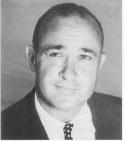 |
Don Veller |
The first era passed quickly and with great promise as Coach Don Veller's 1948, 1949 and 1950 teams won every piece of Dixie Conference hardware available. Those teams lost only twice in three seasons, and never at home in newly constructed Doak Campbell Stadium.
In 1951 the Seminoles left the Dixie Conference behind and crossed the threshold into a considerably more upscale neighborhood featuring opponents like Miami, Georgia Tech, Louisville and then-powerhouse University of Tampa.
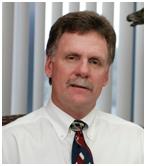 |
Andy Miller |
Two birthdays of note occurred in that summer of 1951. The first was Andy Miller, born in Gadsden County to FSU parents, who along with clusters of cousins and aunts and uncles were part of FSU's post war conversion from distinguished women's university to a modern co-educational institution of higher learning.
The second birth that year was Seminole Boosters, Inc. That summer, newly-minted FSU alumni, along with some Gator grads, business leaders and a scattering of other Old South SEC types, happily banded together to promote Seminole football to the benefit of all.
Andy Miller has spent nearly 40 years - two thirds of his life - as the visionary chief executive of arguably the most accomplished college booster fundraising organization in America. The lives of both the man and the organization parallel each other nicely.
Bob Lee Bannerman, son of a prominent Tallahassee family and campus leader at FSU in the late '40s, was the first Seminole Booster President. As Bannerman tells it, "The first year, we tied into a pretty ambitious goal: $5,000. It turned out that we only raised $397."
And so at the first Booster meeting of 1952, new President Charles Rosenberg quoted humorist Ogden Nash: "Candy is dandy, but liquor is quicker." Bannerman recalls, "Charles proposed that we host a series of cocktail parties, which we did, and the Club quickly raised $12,189."
The name "Seminole Club" was selected over several really bad ideas, incuding "Go FSU" and the "Pow Wows." Early minutes also reflect a discussion of whether membership should be open to women "on exactly the same basis as to men." The proposal passed without note of whether the vote was close.
Records of the early years suggest a more naive time and a sincere struggle with the emerging issues of college athletics. Item No. 9 on a "Progress Report" issued to the board on December 16, 1953, said: "We still need 50 additional football players, which means we need to transport some 300 men into Tallahassee to get our choice of 50 ... which means we need $40,000 more (for scholarships and expenses)."
A few months later, in February of 1954, board minutes included the appointment of a committee to approach the State Board of Control (later the Board of Regents) about "the equitable distribution of monies for scholarships and race track funds." Evidently, the University of Florida was getting most of this money.
Attorney General Dick Ervin is recorded as saying: "Speaking as an alumnus of UF, it is time for the U of F to help FSU from their underdog stage. UF has had its chance for 25 years and the least that can be asked is that FSU be placed on equal scholarship money basis."
Another entry says: "President Rosenberg raised questions regarding a policy of loans to athletes. He stated that he was unwilling to approve such."
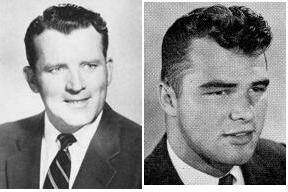 |
Coach Tom Nugent and Buddy Reynolds |
In the spring of 1954, Head Football Coach Tom Nugent signed a freshman running back out of Jupiter named Buddy Reynolds. Reynolds came out of West Palm Beach High School in 1954 with all-state and all-South credentials, and committed to the University of Miami.
But Nugent got Reynolds to visit FSU and took him on a long tour of the beautiful campus, taking great pains to point out the ratio of men to women. Reynolds laughed about it, remembering: "Nugent should really be in my business ... Either that, or he could be one of the most successful used car salesmen in the world ... I decided I didn't want to be a Hurricane after all."
Reynolds went into the lineup as a true freshman, churning out an 8.3 yards-per-carry average along with two touchdowns. One of them was a 54-yard run (Reynolds says it was 60) against Auburn. He was hit and knocked out at the goal line by Auburn defensive back Fob James. James always said that was his claim to fame, even while he was serving as governor of Alabama.
Reynolds then was very much like the character he played later in Smokey & the Bandit. When the Seminoles were invited to play Texas Western in the Sun Bowl in El Paso, legend has it that it was Reynolds and quarterback Lee Corso who led their teammates across the border into Ciudad Guadalajara the night before the game for some additional sightseeing. We lost that game 47-20.
There's no question that the signature victory of those years was when quarterback Vic Prinzi led the Seminoles to the 10-0 shutout of Tennessee in Knoxville in 1958.
 |
Vic Prinzi |
Almost exactly 40 years later I attended Vic Prinzi's funeral in Tampa. The big crowd at St. Lawrence Church was as gray and overcast as the skies. Women in subdued dresses, men in dark coats; the only color was the flash here and there of garnet and gold ties. Coach Bowden was there and Gene Deckerhoff. One of the saddest faces belonged to Jimmy Dunn, the University of Florida quarterback who opposed Prinzi in the 1958 inaugural Seminole/Gator contest. They had stayed pals for those 40 years.
And, of course, there was a special section set aside for Nugent's Boys, as they call themselves. They are the men who played for Coach Tom Nugent in the early, glory years of Seminole football in the mid-1950s after the schedule shifted from Millsaps, Sewanee and Livingston State to Georgia, Auburn and Miami.
Those years were Florida State's adolescence, when the coaching and recruiting genius Nugent invented football's I-formation, the "Typewriter huddle", and inspired hungry and ambitious young players to throw themselves headlong against the giants of the college game.
They were all there to say goodbye to Prinzi. Coach Nugent sat on the end of a row. I remember he was wearing glossy alligator shoes and natty powder-blue Palm Beach blazer in sharp contrast to the dark backdrop of the other mourners.
I didn't talk to him. He was 84 - Coach Bowden's age today. At the time I supposed that he had already buried most of his friends and too many of his players, and he probably said to hell with wearing a shroud. Perhaps he thought, "Life's short and wonderful, and I'm going to wear bright colors and embrace every day."
In our first dozen years of modern football, FSU didn't beat an SEC team. "That shut-out of the Volunteers was our first big win, really," Prinzi said. "It vaulted us into the big time. We'd never been in the top 20 before, and after that game we were."
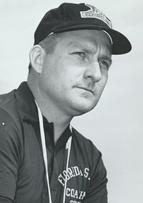 |
Perry Moss |
It's strange how the threads of fate weave around the athletic program. Tom Nugent left Tallahassee at the end of 1958, and a committee set out to hire a new coach. Dean of Men Dr. Don Loucks was friends with West Point Head Coach Red Blaik. Blaik recommended one of his assistant coaches; said he was a terrific coach. Loucks brought the name back to the committee but they decided they wanted a big name; someone already established. And so they hired a fellow named Perry Moss instead of Army assistant coach Vince Lombardi.
But Perry Moss was there only one season (1959) and put up a disappointing 4-6 record before bolting for the Canadian Football League.
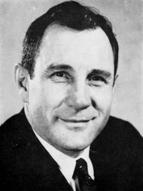 |
Bill Peterson |
That's when Florida State had the good fortune to hire Bill Peterson, an assistant coach on LSU's national championship team. Pete's coaching signature was hiring top talent and giving them a chance to showcase their skills before moving up, often to a head coaching job. Some of the assistant coaches he brought to Tallahassee included Don James, Vince Gibson, Bobby Bowden, Joe Avezzano, Gene McDowell, Joe Gibbs, Dan Henning, Earle Bruce, Kay Stephenson, Bobby Ross and Bill Parcells.
Pete won at Florida State by installing a pro passing attack, and he won the affection of the fans with his juxtapositions and jumbled phrases like, "You don't become a football overnight."
My favorite Pete story had to do with his live broadcast coaches' show in 1963. It was toward the end of the season, right before we played Auburn. Everyone knew that Pete would have to mention Auburn's great All-American running back Tucker Frederickson. Around town there were a lot of friendly bets placed on whether Pete would say the name correctly on live TV. He did not. I'm told it was one of the most requested pieces of archival tape in WCTV history.
From the beginning, the Seminole Boosters used reserved parking at the stadium as a way of raising money and recognizing donors, just as we do today. The early minutes record some initial controversy: "Dr. George Martin brought to the attention of the Club that there has been some criticism from out-of-town visitors about the reserved parking area for the Boosters in front of the stadium." The notes continue to say, "Syde Deeb and President Rosenberg explained that much of this criticism comes from stadium ticket holders, and that this is being corrected through an invitation to each stadium ticket holder to become a member of the Boosters." In other words, we'll be glad to reserve a parking place for you as soon as you join the Boosters.
By the end of the 1950s, annual contributions totaled around $30,000. In 1960, new Head Coach Bill Peterson asked the Boosters for dressing rooms for the coaches, and a weight facility for the players. Those would be useful in building the program, he explained.
In 1963, the Board of Directors "distributed copies of the NCAA regulations and stressed the importance of adherence." The club also organized a charter train to the Miami/FSU game. Transportation, tickets, hotel and ground travel to and from the game came to $68 per couple.
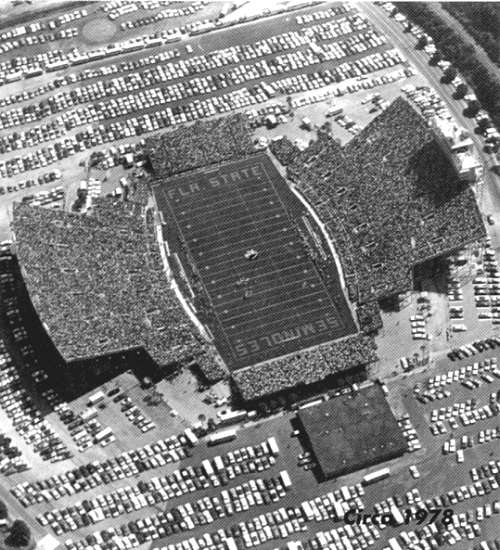 |
Doak Campbell in 1964 |
The minutes of a 1963 meeting reflect "much optimism" on Athletic Director Vaughn Mancha's part about FSU getting into the Southeastern Conference. The University of Florida had agreed to come to Tallahassee for the first time, for a game in 1964 but only on the condition that Doak Campbell Stadium could accommodate increased numbers of fans. And so, Seminole Boosters planned the first Campbell Stadium expansion, increasing capacity to more than 40,000.
The 1962 season was one of the strangest on record. The Seminoles posted 3 ties in 10 games, and all 3 were against Southeastern Conference teams. That year also saw the birth of a great Seminole tradition: the Sod Cemetery. After the 'Noles 18-0 shutout of Georgia in Athens, Gene McDowell brought back a souvenir piece of turf from Sanford Stadium and put it in a little coffin.
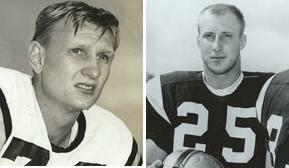 |
Steve Tensi and Fred Biletnikoff |
The final year of our journey is 1963. It was a losing season 4-5-1 but it set the stage for the next year, the greatest season of the 1960s. Quarterback Steve Tensi would thrill fans with long touchdown passes to a freshman named TK Wetherell, and a veteran named Fred Biletnikoff would come to define the role of receiver for the next half century. Both of them would be superbly instructed by Peterson's receivers coach, the young Bobby Bowden.
Our fans may not have recognized the significance of that threshold 50 seasons ago, but Seminole football as they knew it would never be the same again.
And now another threshold has been crossed. Jim Conner wasn't able to accompany the rest of us across the river, as it were. But wherever Jim is I know he's smiling.
Charlie Barnes is the former vice president and executive director of Seminole Boosters.